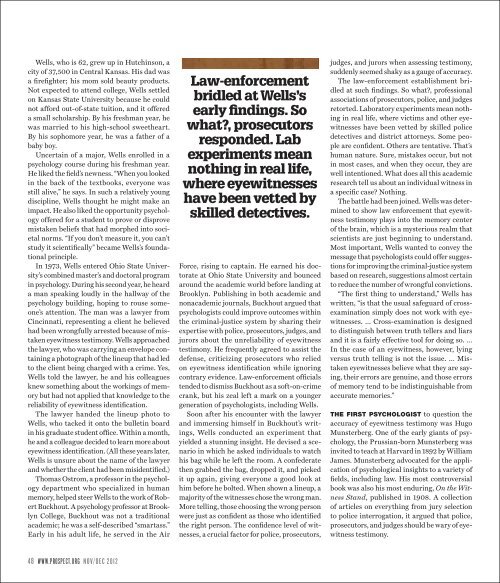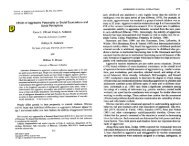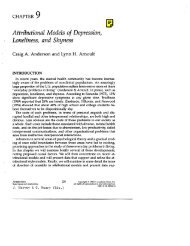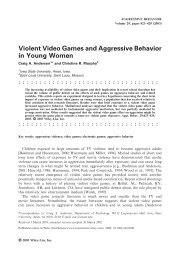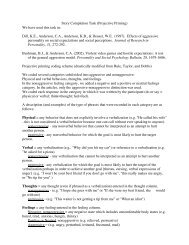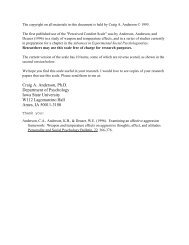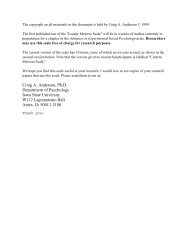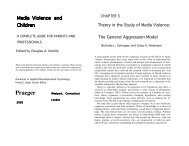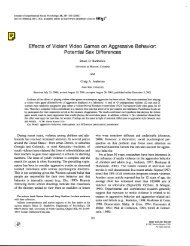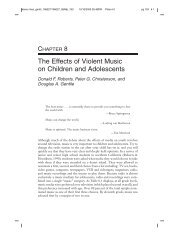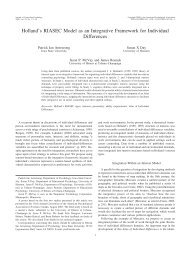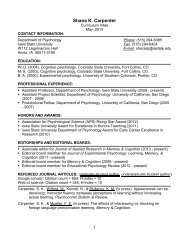Seeing is believing - Department of Psychology - Iowa State University
Seeing is believing - Department of Psychology - Iowa State University
Seeing is believing - Department of Psychology - Iowa State University
Create successful ePaper yourself
Turn your PDF publications into a flip-book with our unique Google optimized e-Paper software.
Wells, who <strong>is</strong> 62, grew up in Hutchinson, a<br />
city <strong>of</strong> 37,500 in Central Kansas. H<strong>is</strong> dad was<br />
a firefighter; h<strong>is</strong> mom sold beauty products.<br />
Not expected to attend college, Wells settled<br />
on Kansas <strong>State</strong> <strong>University</strong> because he could<br />
not afford out-<strong>of</strong>-state tuition, and it <strong>of</strong>fered<br />
a small scholarship. By h<strong>is</strong> freshman year, he<br />
was married to h<strong>is</strong> high-school sweetheart.<br />
By h<strong>is</strong> sophomore year, he was a father <strong>of</strong> a<br />
baby boy.<br />
Uncertain <strong>of</strong> a major, Wells enrolled in a<br />
psychology course during h<strong>is</strong> freshman year.<br />
He liked the field’s newness. “When you looked<br />
in the back <strong>of</strong> the textbooks, everyone was<br />
still alive,” he says. In such a relatively young<br />
d<strong>is</strong>cipline, Wells thought he might make an<br />
impact. He also liked the opportunity psychology<br />
<strong>of</strong>fered for a student to prove or d<strong>is</strong>prove<br />
m<strong>is</strong>taken beliefs that had morphed into societal<br />
norms. “If you don’t measure it, you can’t<br />
study it scientifically” became Wells’s foundational<br />
principle.<br />
In 1973, Wells entered Ohio <strong>State</strong> <strong>University</strong>’s<br />
combined master’s and doctoral program<br />
in psychology. During h<strong>is</strong> second year, he heard<br />
a man speaking loudly in the hallway <strong>of</strong> the<br />
psychology building, hoping to rouse someone’s<br />
attention. The man was a lawyer from<br />
Cincinnati, representing a client he believed<br />
had been wrongfully arrested because <strong>of</strong> m<strong>is</strong>taken<br />
eyewitness testimony. Wells approached<br />
the lawyer, who was carrying an envelope containing<br />
a photograph <strong>of</strong> the lineup that had led<br />
to the client being charged with a crime. Yes,<br />
Wells told the lawyer, he and h<strong>is</strong> colleagues<br />
knew something about the workings <strong>of</strong> memory<br />
but had not applied that knowledge to the<br />
reliability <strong>of</strong> eyewitness identification.<br />
The lawyer handed the lineup photo to<br />
Wells, who tacked it onto the bulletin board<br />
in h<strong>is</strong> graduate student <strong>of</strong>fice. Within a month,<br />
he and a colleague decided to learn more about<br />
eyewitness identification. (All these years later,<br />
Wells <strong>is</strong> unsure about the name <strong>of</strong> the lawyer<br />
and whether the client had been m<strong>is</strong>identified.)<br />
Thomas Ostrom, a pr<strong>of</strong>essor in the psychology<br />
department who specialized in human<br />
memory, helped steer Wells to the work <strong>of</strong> Robert<br />
Buckhout. A psychology pr<strong>of</strong>essor at Brooklyn<br />
College, Buckhout was not a traditional<br />
academic; he was a self-described “smartass.”<br />
Early in h<strong>is</strong> adult life, he served in the Air<br />
Law-enforcement<br />
bridled at Wells’s<br />
early findings. So<br />
what?, prosecutors<br />
responded. Lab<br />
experiments mean<br />
nothing in real life,<br />
where eyewitnesses<br />
have been vetted by<br />
skilled detectives.<br />
Force, r<strong>is</strong>ing to captain. He earned h<strong>is</strong> doctorate<br />
at Ohio <strong>State</strong> <strong>University</strong> and bounced<br />
around the academic world before landing at<br />
Brooklyn. Publ<strong>is</strong>hing in both academic and<br />
nonacademic journals, Buckhout argued that<br />
psycholog<strong>is</strong>ts could improve outcomes within<br />
the criminal-justice system by sharing their<br />
expert<strong>is</strong>e with police, prosecutors, judges, and<br />
jurors about the unreliability <strong>of</strong> eyewitness<br />
testimony. He frequently agreed to ass<strong>is</strong>t the<br />
defense, criticizing prosecutors who relied<br />
on eyewitness identification while ignoring<br />
contrary evidence. Law-enforcement <strong>of</strong>ficials<br />
tended to d<strong>is</strong>m<strong>is</strong>s Buckhout as a s<strong>of</strong>t-on-crime<br />
crank, but h<strong>is</strong> zeal left a mark on a younger<br />
generation <strong>of</strong> psycholog<strong>is</strong>ts, including Wells.<br />
Soon after h<strong>is</strong> encounter with the lawyer<br />
and immersing himself in Buckhout’s writings,<br />
Wells conducted an experiment that<br />
yielded a stunning insight. He dev<strong>is</strong>ed a scenario<br />
in which he asked individuals to watch<br />
h<strong>is</strong> bag while he left the room. A confederate<br />
then grabbed the bag, dropped it, and picked<br />
it up again, giving everyone a good look at<br />
him before he bolted. When shown a lineup, a<br />
majority <strong>of</strong> the witnesses chose the wrong man.<br />
More telling, those choosing the wrong person<br />
were just as confident as those who identified<br />
the right person. The confidence level <strong>of</strong> witnesses,<br />
a crucial factor for police, prosecutors,<br />
judges, and jurors when assessing testimony,<br />
suddenly seemed shaky as a gauge <strong>of</strong> accuracy.<br />
The law-enforcement establ<strong>is</strong>hment bridled<br />
at such findings. So what?, pr<strong>of</strong>essional<br />
associations <strong>of</strong> prosecutors, police, and judges<br />
retorted. Laboratory experiments mean nothing<br />
in real life, where victims and other eyewitnesses<br />
have been vetted by skilled police<br />
detectives and d<strong>is</strong>trict attorneys. Some people<br />
are confident. Others are tentative. That’s<br />
human nature. Sure, m<strong>is</strong>takes occur, but not<br />
in most cases, and when they occur, they are<br />
well intentioned. What does all th<strong>is</strong> academic<br />
research tell us about an individual witness in<br />
a specific case? Nothing.<br />
The battle had been joined. Wells was determined<br />
to show law enforcement that eyewitness<br />
testimony plays into the memory center<br />
<strong>of</strong> the brain, which <strong>is</strong> a mysterious realm that<br />
scient<strong>is</strong>ts are just beginning to understand.<br />
Most important, Wells wanted to convey the<br />
message that psycholog<strong>is</strong>ts could <strong>of</strong>fer suggestions<br />
for improving the criminal-justice system<br />
based on research, suggestions almost certain<br />
to reduce the number <strong>of</strong> wrongful convictions.<br />
“The first thing to understand,” Wells has<br />
written, “<strong>is</strong> that the usual safeguard <strong>of</strong> crossexamination<br />
simply does not work with eyewitnesses.<br />
… Cross-examination <strong>is</strong> designed<br />
to d<strong>is</strong>tingu<strong>is</strong>h between truth tellers and liars<br />
and it <strong>is</strong> a fairly effective tool for doing so. …<br />
In the case <strong>of</strong> an eyewitness, however, lying<br />
versus truth telling <strong>is</strong> not the <strong>is</strong>sue. … M<strong>is</strong>taken<br />
eyewitnesses believe what they are saying,<br />
their errors are genuine, and those errors<br />
<strong>of</strong> memory tend to be ind<strong>is</strong>tingu<strong>is</strong>hable from<br />
accurate memories.”<br />
The first psycholog<strong>is</strong>t to question the<br />
accuracy <strong>of</strong> eyewitness testimony was Hugo<br />
Munsterberg. One <strong>of</strong> the early giants <strong>of</strong> psychology,<br />
the Prussian-born Munsterberg was<br />
invited to teach at Harvard in 1892 by William<br />
James. Munsterberg advocated for the application<br />
<strong>of</strong> psychological insights to a variety <strong>of</strong><br />
fields, including law. H<strong>is</strong> most controversial<br />
book was also h<strong>is</strong> most enduring, On the Witness<br />
Stand, publ<strong>is</strong>hed in 1908. A collection<br />
<strong>of</strong> articles on everything from jury selection<br />
to police interrogation, it argued that police,<br />
prosecutors, and judges should be wary <strong>of</strong> eyewitness<br />
testimony.<br />
48 WWW.Prospect.org nov/dec 2012


